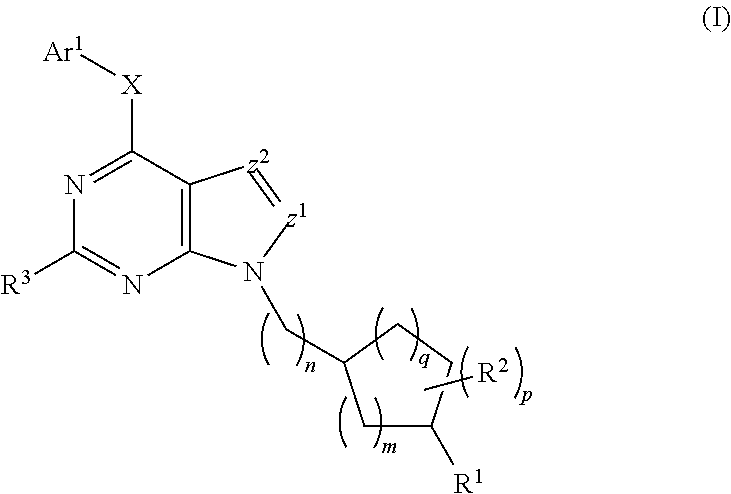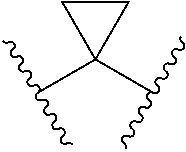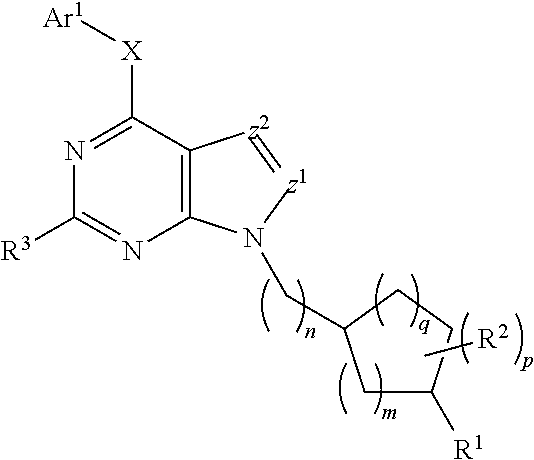Modulators of glucose homeostasis for the treatment of diabetes and metabolic disorders
a technology of insulin homeostasis and glucose homeostasis, which is applied in the direction of biocide, drug composition, metabolic disorder, etc., can solve the problems of hyperglycemia (abnormally high level of glucose in the blood), patients with high levels of these antibodies develop type i diabetes, and achieve the effect of increasing insulin secretion
- Summary
- Abstract
- Description
- Claims
- Application Information
AI Technical Summary
Benefits of technology
Problems solved by technology
Method used
Image
Examples
example 1
tert-butyl 4-(4-(4-(methylsulfonyl)phenoxy)-1H-pyrazolo[3,4-d]pyrimidin-1-yl)piperidine-1-carboxylate (2)
[0236]
Step A: To a solution of 4-chloro-1H-pyrazolo[3,4-d]pyrimidine (0.85 g, 6 mmol), 4-amino-piperidine-1-carboxylic acid tert-butyl ester (1.2 g, 6 mmol) and triphenylphosphine (1.9 g, 7.2 mmol) in THF (20 mL) was added diethyl azodicarboxylate (1.25 g, 7.2 mmol) at 0° C. The mixture was stirred at room temperature for 18 h and concentrated in vacuo. The residue was treated with Et2O and filtered. The filtrate was concentrated in vacuo and the residue was purified by silica gel chromatography to yield the desired intermediate (1).
Step B: To a solution of intermediate 1 (obtained as described in Step A) (0.16 g, 0.5 mmol) and 4-methanesulfonyl-phenol (0.1 g, 0.6 mmol) in DMF (10 mL) was added potassium carbonate (0.14 g, 1 mmol). The mixture was stirred at 90° C. for 5 hours and diluted with ethyl acetate, washed with water, brine, dried over sodium sulfate and concentrated in ...
example 2
tert-butyl 4-(4-(4-methoxyphenoxy)-1H-pyrazolo[3,4-d]pyrimidin-1-yl)piperidine-1-carboxylate (3)
[0238]
[0239]1H NMR (CDCl3) δ 8.53 (1H, s), 7.77 (1H, s), 7.16 (2H, d, J=8.8 Hz), 6.98 (2H, d, J=8.8 Hz), 5.0˜4.9 (1H, m), 4.4˜4.2 (2H, m), 3.85 (3H, s), 3.05˜2.9 (2H, m), 2.3˜2.18 (2H, m), 2.05˜1.95 (2H, m), 1.48 (9H, s).
example 3
tert-butyl 4-(4-(4-(4-(trifluoromethyl)phenoxy)phenoxy)-1H-pyrazolo[3,4-d]pyrimidin-1-yl)piperidine-1-carboxylate (4)
[0240]
[0241]1H NMR (CDCl3) δ 8.54 (1H, s), 7.96 (1H, s), 7.61 (2H, d, J=8.4 Hz), 7.3˜7.24 (2H, m), 7.1˜7.18 (4H, m), 5˜4.9 (1H, m), 4.4˜4.2 (2H, m), 3.05˜2.9 (2H, m), 2.3˜2.18 (2H, m), 2.05˜1.95 (2H, m), 1.49 (9H, s).
PUM
| Property | Measurement | Unit |
|---|---|---|
| waist circumference | aaaaa | aaaaa |
| waist circumference | aaaaa | aaaaa |
| weight | aaaaa | aaaaa |
Abstract
Description
Claims
Application Information
 Login to View More
Login to View More - R&D
- Intellectual Property
- Life Sciences
- Materials
- Tech Scout
- Unparalleled Data Quality
- Higher Quality Content
- 60% Fewer Hallucinations
Browse by: Latest US Patents, China's latest patents, Technical Efficacy Thesaurus, Application Domain, Technology Topic, Popular Technical Reports.
© 2025 PatSnap. All rights reserved.Legal|Privacy policy|Modern Slavery Act Transparency Statement|Sitemap|About US| Contact US: help@patsnap.com



